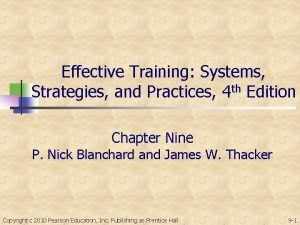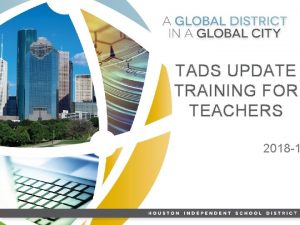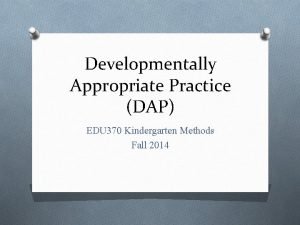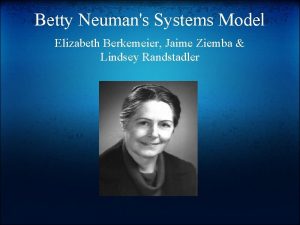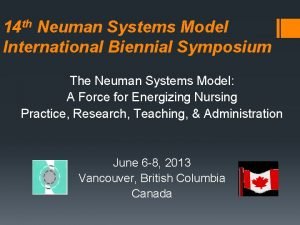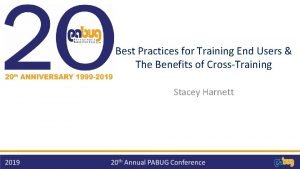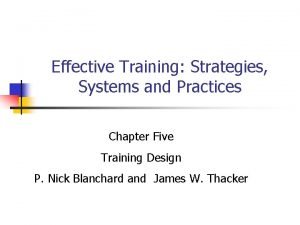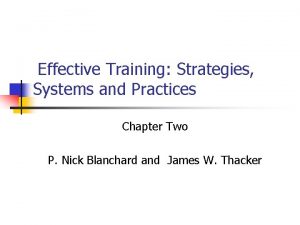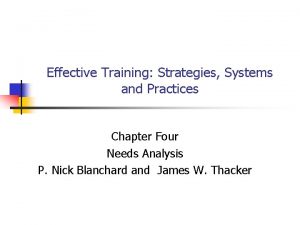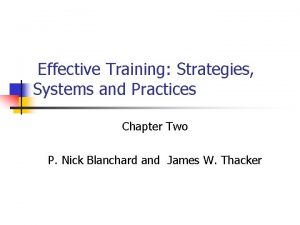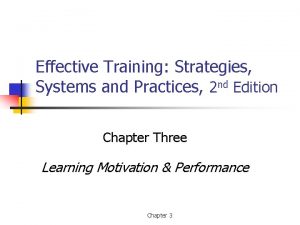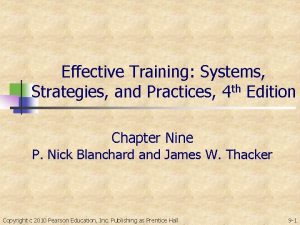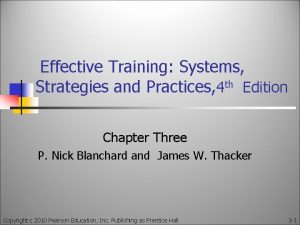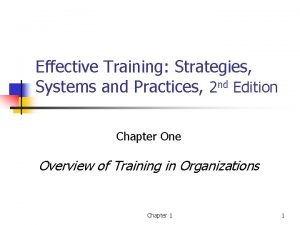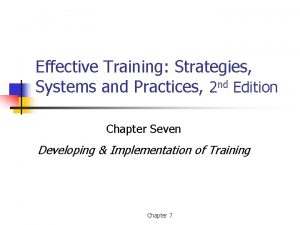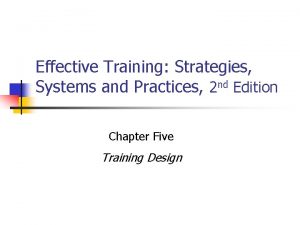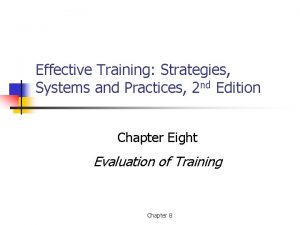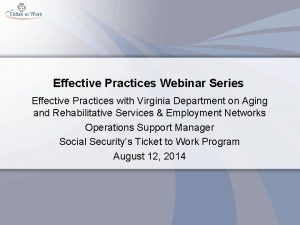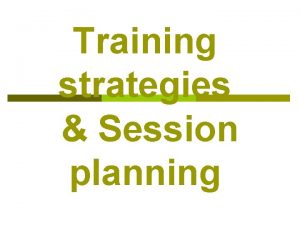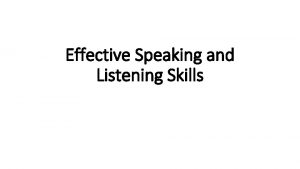Effective Training Strategies Systems and Practices Chapter One



















- Slides: 19

Effective Training: Strategies, Systems and Practices Chapter One Overview of Training in Organizations Chapter 1 1

Session Overview n n n Define training& learning Define and differentiate among knowledge, skills, and attitudes Describe the components of a open systems model and training processes model Chapter 1 2

Overview of Training defined: “Training is a set of processes aimed at continuously improving employee and organizational systems” (p. 4) Chapter 1 3

Opportunities for the Millennium Demographics Shifts occur because: n Aging of the population n n Companies face a severe shortage of skilled employees Lower birth rates Increased diversity of ethnic and cultural makeup Differing values of new generations of employees n New work systems must be adopted to allow employees to work outside “company walls” Chapter 1 4

Opportunities for the Millennium Knowledge Workers: “The 21 st century will see the value of products and services determined more by the knowledge of the workforce and less by physical labor” (p. 5) Chapter 1 5

Opportunities for the Millennium Quality: n n High quality products and services are necessary just to stay in business Example: ISO 9000 Chapter 1 6

Important Concepts Learning: “a relatively permanent change in understanding and thinking that results from experience and directly influences behavior” (p. 7) Chapter 1 7

Classification of Learning Outcome Skill-Based Learning §Compilation §Automaticity Learning Cognitive Knowledge §Declarative Knowledge §Procedural Knowledge §Strategic Knowledge Attitudinal Learning §Affect/Feelings Chapter 1 8

Important Concepts KSAs: Knowledge, Skill, & Attitude n Knowledge – the facts people learn & the strategies they learn for using those facts Declarative – storing factual information Procedural – applying facts already learned Strategic – using declarative & procedural knowledge to plan goal directing activity Chapter 1 9

Important Concepts n n KSAs: Knowledge, Skill, & Attitude Skill - the capacities needed to perform a set of tasks that are developed as a result of training & experience n Compilation- when a person just learns a n Automaticity - when a person is able to specific skill perform a skill without thinking about what they are doing Chapter 1 10

Important Concepts KSAs: Knowledge, Skill, & Attitude n Attitude – n Attitude directly affects Motivation employees belief & opinion that support or inhibit behavior Chapter 1 11

Important Concepts Competencies: “A broad grouping of knowledge, skills, & attitudes that enable a person to be successful at a number of similar tasks” - KSAs are the foundation of competencies - Example: Carpenter Chapter 1 12

Organizational Chart for Human Resource Function Vice President Human Resources HR Planning and Research Director Forecasting employment needs Succession planning Conducting research Employment Director Recruiting Employee Relations Compensation Human Resource Development Director Employee grievances Testing Hiring and employee termination In unionized firms management-union relations often involved in labor negotiations Chapter 1 Compensation of employees (wages, salaries and benefits) Negotiates with outside benefit providers Improving the capabilities of employees If no director of Health & Safety exists this activity may fall under HRD 13

Possible Career Path in HRD Director HRD Rotation through other HRD management positions Manager, Training Support Services Supervisor of Materials Development Rotation through other specialist positions Entry-level specialist position (e. g. , training materials developer) Chapter 1 14

Open Systems Model Characteristic of an Open Systems Model: n n Have a dynamic relationship with their environment. Are barriers restricting the flow from the external environment The system is open to influences from its environment. Inputs are transformed into outputs through a process. Chapter 1 15

Open Systems Model Example OPEN SYSTEM INPUT PROCESS OUTPUT Systems External Environment Chapter 1 16

Training as a Subsystem within the Organizational System TRAINING’S ORGANIZATIONAL ENVIRONMENT Mission Strategy Structure Finances Resources People Policies Procedures Products Technology TRAINING SUBSYSTEM INPUT Organizational Needs Employee Needs Budget Equipment Staff PROCESS OUTPUT Analysis Design Development Implementation Evaluation Knowledge Skills Attitudes Motivation Job Performance Chapter 1 17

Training Processes Model Needs Analysis Phase Input Process Output Design Phase Input Process Output Triggering Event Development Phase Input Process Output Implementation Phase Input Process Output Outcome Evaluation Data Chapter 1 Process Evaluation Data Evaluation Phase Input Process Output 18

Training Processes Model n n n Needs Analysis – determination of organizations needs Design Phase – identifying the factors needed in the training program Development – formulating an instructional strategy Implementation – conducting the training Evaluation – judge the quality of the training Chapter 1 19
 Effective training systems strategies and practices
Effective training systems strategies and practices Hisd tads manual
Hisd tads manual Dap kindergarten
Dap kindergarten Interpersonal communication chapter 6
Interpersonal communication chapter 6 Intrusive academic advising
Intrusive academic advising Twelfth night speeches
Twelfth night speeches Systems integration plan
Systems integration plan One god one empire one emperor
One god one empire one emperor One one little dog run
One one little dog run One king one law one faith
One king one law one faith One empire one god one emperor
One empire one god one emperor One ford behaviors
One ford behaviors See one do one teach one
See one do one teach one See one, do one, teach one
See one, do one, teach one See one do one teach one
See one do one teach one Asean tourism strategic plan
Asean tourism strategic plan Graphic organizer with the aims of la liga filipina
Graphic organizer with the aims of la liga filipina Using the neuman systems model for best practices
Using the neuman systems model for best practices Using the neuman systems model for best practices
Using the neuman systems model for best practices End user training best practices
End user training best practices
